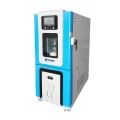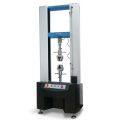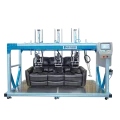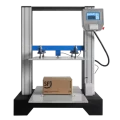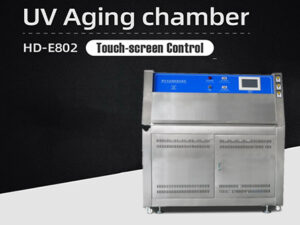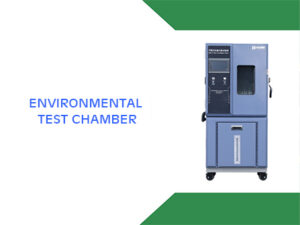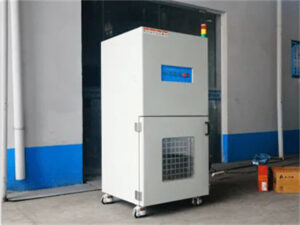Haida cold and thermal shock test chambers are used for the necessary testing equipment in the metal, plastic, rubber, electronics, and other material industries. The degree of chemical change or physical damage caused by thermal expansion and contraction of test materials and products in a short period of time. The thermal shock testing machine is widely used in the quality inspection and testing of metals, plastics, rubber, cables and wires, and other industries, and can be used as the basis or reference for product improvement. The test methods that the thermal shock test chamber meets: are GB/T2423.1.2, GB/T10592-2008, and GJB150.3 high and low-temperature impact tests. Haida thermal shock testing machine has two-box and three-box thermal shock testing machines.
Overview of the two-box thermal shock test chamber:
The two-box temperature shock test box, as the name suggests, has only two studios, one is the high-temperature area and the other is the low-temperature area. When the impact is working, it is only necessary to move the test piece to the opposite studio through the hanging rail, and the energy loss is relatively Compared with the three-slot type, the configuration is small, the cost is low, and the failure rate is correspondingly low.
HD-E703-150K40 two-box water-cooled impact test chamber
Overview of the three-box cold and thermal shock test chamber:
The three-box temperature shock test chamber has three working chambers, which are mainly used for the test object that cannot be moved, or the test with load (power on or external measurement sensor, etc.). The temperature of the chamber or preheating chamber is brought into the working chamber to realize rapid impact change of temperature; since one more working chamber area is added to the two-box impact test chamber, when the temperature rises and falls, the requirements for the precooling heat are higher. The allocation of power and energy storage devices is also large, and the cost increases accordingly.
Both high and low refrigeration cycles adopt the reverse calorie cycle, which consists of two isothermal processes and two adiabatic processes. The process is as follows: the refrigerant is compressed adiabatically by the compressor to a higher pressure, which consumes work to increase the exhaust temperature, and then the refrigerant exchanges heat with the surrounding medium isothermally through the condenser, and transfers heat to the surrounding medium. After the refrigerant expands adiabatically through the valve to do work, the temperature of the refrigerant decreases. The refrigerant absorbs heat isothermally from the higher temperature object through the evaporator, so that the temperature of the cooled object is lowered. This cycle is repeated to achieve the purpose of cooling.
HD-E703-50K55 three-box water-cooled impact test chamber
The four major differences between the two-box cold and thermal shock test chamber and the three-box cold and thermal shock test chamber:
1. Curves of two temperature shock test chambers:
Two boxes of cold and hot shock test chamber: There is no room temperature stay stage, only high temperature and low temperature stay, there is an obvious overshoot phenomenon in the early stage of high and low temperature stay.
Three-box cold and hot shock test chamber: There is a normal temperature stay stage. Due to different control principles, the high and low temperature and normal temperature stay stages are similar to the sine function curve.
2. The functions of two temperature shock test chambers:
Two boxes of thermal shock test boxes: two boxes, a high-temperature box, and a low-temperature box, with a hanging basket in the middle. During the test, the sample is placed in the hanging basket. When the high-temperature test is performed, the hanging basket is raised to the high-temperature box, and vice versa, the low-temperature test is performed. The temperature is fast; the structure is compact, and the volume is generally small; the conversion time is short, and the product needs to be moved during the test; it can be used as a thermal shock box and can be used as a separate high-temperature box or a separate low-temperature box.
Three boxes of thermal shock test boxes: three boxes, the high-temperature box, the box where the samples are placed, and the low-temperature box. When testing high temperature, the high-temperature box door is opened and the low-temperature box door is closed. When testing low temperature, the high-temperature box door is closed and the low-temperature box door is opened; it is at room temperature, which is convenient for taking and placing samples; the product does not move, and the impact of product movement on the product can be reduced, and some sensitive electrical signal monitoring lines can be connected; the conversion time is relatively long.
3. Features of the two temperature shock test chambers:
Compared with the three-box type, it can test the adaptability of the product to withstand sudden changes in ambient temperature.
4. The structure of two kinds of temperature shock test chamber tests:
The overall structure of the two-box temperature shock test box: the test box consists of a preheating room, a precooling room, a refrigeration system, a heating system, an air duct system, and an electrical control system. The pre-cooling chamber is located at the upper back of the test box, the preheating chamber is located at the front and lower part of the test box, the refrigerator is located at the rear and lower part of the test box, and the electrical control cabinet is located on the right side of the text box.
The overall structure of the three-box temperature shock test box: the sample item is completely stationary. The test box consists of a preheating room, a precooling room, a working room, a refrigeration system, a heating system, an air duct system, and an electrical control system. The studio is located in the middle of the test box, the high-temperature room is located in the lower part of the test box, the low-temperature room is located in the upper part of the test box, and the refrigerator system is located in the rear lower part of the test box, and the electrical control cabinet is located in the upper part of the right side of the text box.
The Haida cold and thermal shock test chamber adopt imported compressors and Schneider Electric accessories, plus an advanced argon arc welding process to ensure stable performance, energy saving, and high efficiency.


